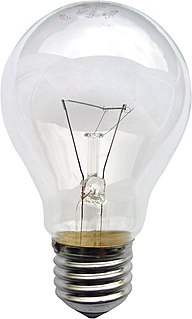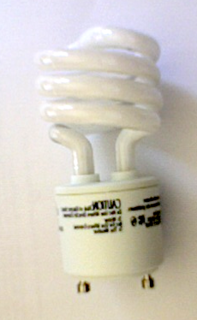
An electric light, lamp, or colloquially called light bulb is an electrical device that produces light. It is the most common form of artificial lighting. Lamps usually have a base made of ceramic, metal, glass, or plastic, which secures the lamp in the socket of a light fixture. The electrical connection to the socket may be made with a screw-thread base, two metal pins, two metal caps or a bayonet cap.

An incandescent light bulb, incandescent lamp or incandescent light globe is an electric light with a wire filament heated until it glows. The filament is enclosed in a glass bulb with a vacuum or inert gas to protect the filament from oxidation. Current is supplied to the filament by terminals or wires embedded in the glass. A bulb socket provides mechanical support and electrical connections.

A fluorescent lamp, or fluorescent tube, is a low-pressure mercury-vapor gas-discharge lamp that uses fluorescence to produce visible light. An electric current in the gas excites mercury vapor, which produces short-wave ultraviolet light that then causes a phosphor coating on the inside of the lamp to glow. A fluorescent lamp converts electrical energy into useful light much more efficiently than an incandescent lamp. The typical luminous efficacy of fluorescent lighting systems is 50–100 lumens per watt, several times the efficacy of incandescent bulbs with comparable light output. For comparison, the luminous efficacy of an incandescent bulb may only be 16 lumens per watt.

Lighting or illumination is the deliberate use of light to achieve practical or aesthetic effects. Lighting includes the use of both artificial light sources like lamps and light fixtures, as well as natural illumination by capturing daylight. Daylighting is sometimes used as the main source of light during daytime in buildings. This can save energy in place of using artificial lighting, which represents a major component of energy consumption in buildings. Proper lighting can enhance task performance, improve the appearance of an area, or have positive psychological effects on occupants.

Energy conservation is the effort made to reduce the consumption of energy by using less of an energy service. This can be achieved either by using energy more efficiently or by reducing the amount of service used. Energy conservation is a part of the concept of Eco-sufficiency. Energy conservation measures (ECMs) in buildings reduce the need for energy services and can result in increased environmental quality, national security, personal financial security and higher savings. It is at the top of the sustainable energy hierarchy. It also lowers energy costs by preventing future resource depletion.

A compact fluorescent lamp (CFL), also called compact fluorescent light, energy-saving light and compact fluorescent tube, is a fluorescent lamp designed to replace an incandescent light bulb; some types fit into light fixtures designed for incandescent bulbs. The lamps use a tube that is curved or folded to fit into the space of an incandescent bulb, and a compact electronic ballast in the base of the lamp.

Material efficiency is a description or metric which expresses the degree in which raw materials are consumed, incorporated, or wasted, as compared to previous measures in construction projects or physical processes. Making a usable item out of thinner stock than a prior version increases the material efficiency of the manufacturing process. Material efficiency goes hand in hand with Green building and Energy conservation, as well as any other ways of incorporating Renewable resources in the building process from start to finish.

Overillumination is the presence of lighting intensity higher than that which is appropriate for a specific activity. Overillumination was commonly ignored between 1950 and 1995, especially in office and retail environments. Since then, however, the interior design community has begun to reconsider this practice. Overillumination encompasses two separate concerns:
Fiscal Environmentalism is a hybrid term of two traditional and often conflicting philosophies, environmentalism and fiscal conservatism, created to emphasize the growing understanding of the middle ground between the two, where the goals of each are simultaneously fulfilled. The result is a business practice based upon principles of intelligent environmental design and financial discipline, associated with each.

A grow light is an electric light to help plants grow. Grow lights either attempt to provide a light spectrum similar to that of the sun, or to provide a spectrum that is more tailored to the needs of the plants being cultivated. Outdoor conditions are mimicked with varying colour temperatures and spectral outputs from the grow light, as well as varying the intensity of the lamps. Depending on the type of plant being cultivated, the stage of cultivation, and the photoperiod required by the plants, specific ranges of spectrum, luminous efficacy and color temperature are desirable for use with specific plants and time periods.

The Energy Independence and Security Act of 2007, originally named the Clean Energy Act of 2007, is an Act of Congress concerning the energy policy of the United States. As part of the Democratic Party's 100-Hour Plan during the 110th Congress, it was introduced in the United States House of Representatives by Representative Nick Rahall of West Virginia, along with 198 cosponsors. Even though Rahall was 1 of only 4 Democrats to oppose the final bill, it passed in the House without amendment in January 2007. When the Act was introduced in the Senate in June 2007, it was combined with Senate Bill S. 1419: Renewable Fuels, Consumer Protection, and Energy Efficiency Act of 2007. This amended version passed the Senate on June 21, 2007. After further amendments and negotiation between the House and Senate, a revised bill passed both houses on December 18, 2007 and President Bush, a Republican, signed it into law on December 19, 2007, in response to his "Twenty in Ten" challenge to reduce gasoline consumption by 20% in 10 years.

An LED lamp or LED light bulb is an electric light that produces light using light-emitting diodes (LEDs). LED lamps are significantly more energy-efficient than equivalent incandescent lamps and can be significantly more efficient than most fluorescent lamps. The most efficient commercially available LED lamps have efficiencies of 200 lumen per watt (Lm/W). Commercial LED lamps have a lifespan many times longer than incandescent lamps.

Governments around the world have passed measures to phase out incandescent light bulbs for general lighting in favor of more energy-efficient lighting alternatives. Phase-out regulations effectively ban the manufacture, or importation of incandescent light bulbs for general lighting. The regulations are based on efficiency, rather than use of incandescent technology. However, it is not unlawful to continue to buy or sell existing bulbs, which are unregulated.
Electron-stimulated luminescence (ESL) is production of light by cathodoluminescence, i.e. by a beam of electrons made to hit a fluorescent phosphor surface. This is also the method used to produce light in a cathode ray tube (CRT). Experimental light bulbs that were made using this technology, do not include magnetic or electrostatic means to deflect the electron beam.
United States Lighting Energy Policy is moving towards increased efficiency in order to lower greenhouse gas emissions and energy use. Lighting efficiency improvements in the United States can be seen through different standards and acts. The Energy Independence and Security Act of 2007 laid out changes in lighting legislation for the United States. This set up performance standards and the phase-out of incandescent light bulbs in order to require the use of more efficient fluorescent lighting. EISA 2007 is an effort to increase lighting efficiency by 25-30%. Opposition to EISA 2007 is demonstrated by the Better Use of Light Bulbs Act and the Light Bulb Freedom of Choice Act. The efforts to increase lighting efficiency are also demonstrated by the Energy Star program and the increase efficiency goals by 2011 and 2013.

Fluorescent lamps have been suggested to affect human health in various ways.
Choice editing refers to the active process of controlling or limiting the choices available to consumers so as to drive to an end goal, specifically by banning things or imposing punitive taxation. The term has gained currency in discussions about sustainability.
Customer cost refers not only to the price of a product, but it also encompasses the purchase costs, use costs and the post-use costs. Purchase costs consist of the cost of searching for a product, gathering information about the product and the cost of obtaining that information. Usually, the highest use costs arise for durable goods that have a high demand on resources, such as energy or water, or those with high maintenance costs. Post-use costs encompass the costs for collecting, storing and disposing of the product once the item has been discarded.

A GU24 lamp fitting is a bi-pin connector for compact fluorescent lamps (CFL) or LED lamps that uses a bayonet mount–like twist-lock bi-pin connector instead of the Edison screw fitting used on many CFLs, LED lamps and incandescent light bulbs. The design was initiated by the U.S. EPA and the Lighting Research Center in 2004, in order to facilitate the deployment of compact fluorescent light bulbs with replaceable ballasts.
Edison light bulbs, retroactively referred to as antique light bulbs or vintage light bulbs, refer to carbon- or early tungsten-filament incandescent lamps, or modern bulbs that reproduce their appearance. Most of the bulbs in circulation are reproductions of the wound filament bulbs made popular by Edison Electric Light Company at the turn of the 20th century. They are easily identified by the long and complicated windings of their internal filaments, and by the very warm-yellow glow of the light they produce.














